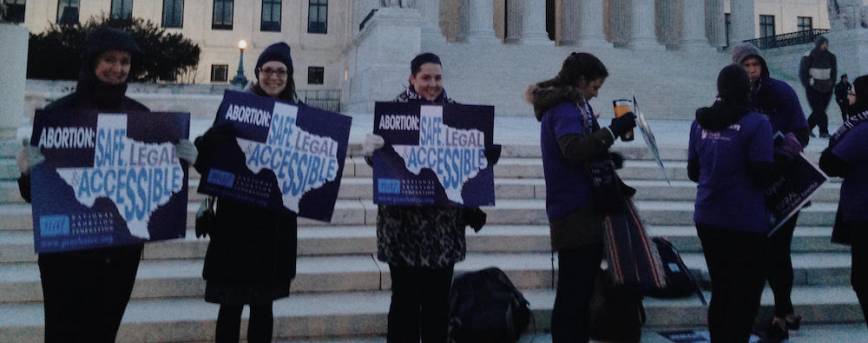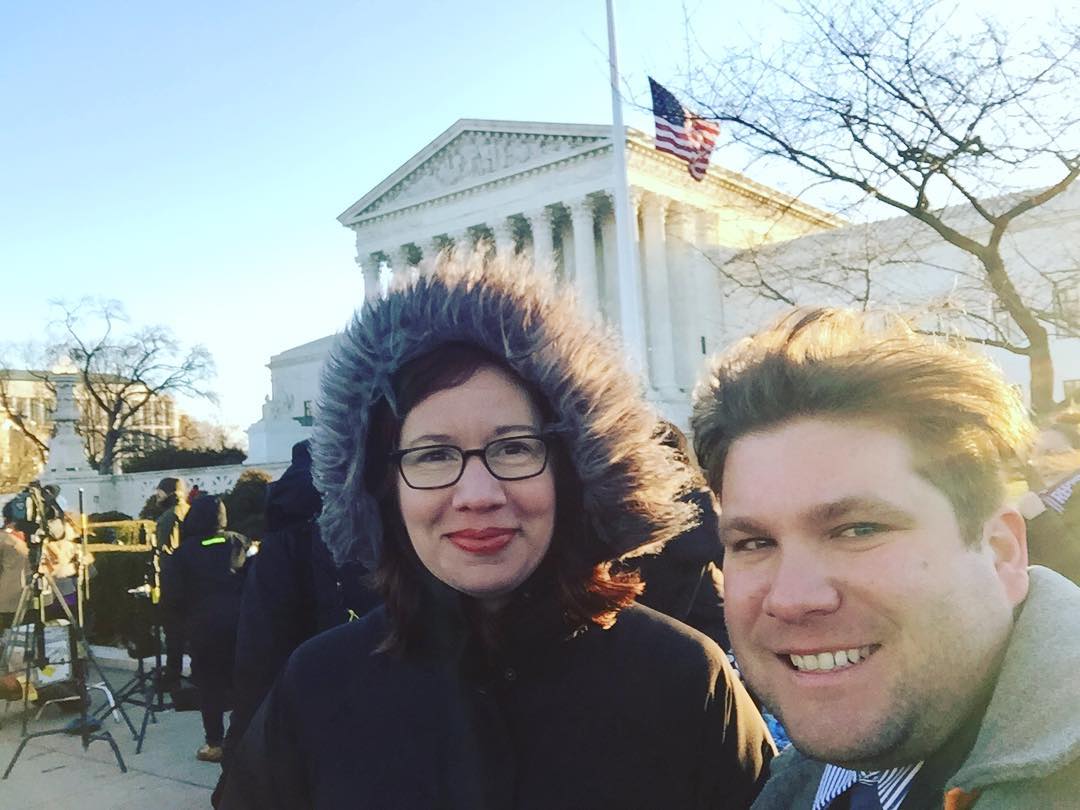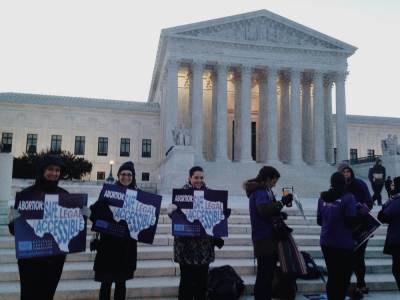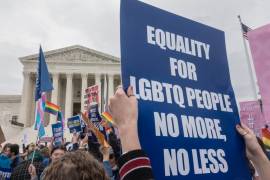
What Happened at the Supreme Court Arguments in the Texas Abortion Case
Blog Search

The Supreme Court held argument yesterday in what could turn out to be the most important abortion case in over a decade. In Whole Woman’s Health v. Hellerstedt, Texas clinics and physicians who perform abortions are challenging the constitutionality of two provisions of HB 2, an infamous anti-abortion law that, if allowed to go into effect, would force the vast majority of Texas’s abortion clinics to close.
Lambda Legal filed a friend-of-the-court brief in this case, arguing that landmark decisions vindicating the rights of LGBT people compel the conclusion that the constitutional right to choose to have an abortion finds protection under the Equal Protection Clause as well as the Due Process Clause of the federal Constitution.
Learn more: Reproductive Freedom at the Supreme Court
Furthermore, the landmark Supreme Court cases on which both LGBT people and women (whether LBT or not) depend for vindication of their constitutional guarantees of liberty and equality share a common legal foundation. If the Court erodes any of these precedents, we all lose, and LGBT civil rights are at risk.

Lambda Legal attorneys Camilla Taylor and Omar Gonazalez-Pagan at the Supreme Court yesterday.
Specifically, the clinics and doctors challenge: 1) HB2’s requirement that a physician performing or inducing an abortion have admitting privileges at a hospital located no further than 30 miles from the location where the abortion is induced; and 2) HB2’s ambulatory surgical center (ASC) licensing requirement, which mandates that abortion clinics meet structural and operational standards appropriate for mini hospitals.
Texas asserts—and the Fifth Circuit Court of Appeals agreed—that courts must accept at face value Texas’s claim, developed in litigation after the law was challenged, that the purpose of its new abortion restrictions is to protect women’s health, no matter how obvious it may be that this is mere pretext, and the restrictions in fact were passed to shut down clinics, and are harmful to women’s health.
This is a perversion of the governing standard for reviewing abortion restrictions laid out in Planned Parenthood v. Casey, a 1992 case in which Justice Kennedy is the lone remaining justice on the Court who was part of the majority.
The Casey test for whether laws restricting abortion violate the Constitution is whether such restrictions amount to an “undue burden” on abortion access. If the Court applies the undue burden standard in a manner faithful to Casey, and consistently with the way in which the vast majority of lower courts have interpreted it, the Court will strike down Texas’s abortion restrictions as unconstitutional.
As I sat in the Court gallery to watch the arguments it was clear that the questions asked by the justices revealed a deeply divided Court. As is true in so many cases, Justice Kennedy appears to be the swing justice whose opinion is likely to drive the result. Although Justice Kennedy’s questions gave both sides cause for hope, in the end, the plaintiffs’ attorneys likely feel better about the tenor and import of his questions than do attorneys for Texas defending the abortion restrictions.
First, the bad news for abortion rights advocates—
The argument began with a series of questions about the procedural posture of the case to Stephanie Toti, a lawyer with the Center for Reproductive Rights who represents the petitioner clinics and physicians.
Justices Kennedy, Ginsburg, Alito and Roberts wondered whether it would be appropriate to reach constitutionality of HB2 at all in this case—at least at this juncture—given the convoluted path the case had taken in lower courts before arriving at the Court’s doorstep. Several justices expressed concern about whether there was sufficient evidence in the record tying the closure of clinics to the new Texas law.
Justice Kennedy suggested that the Court might send the case back to the trial court for more fact-finding—perhaps over the course of two to three years—about the impact of HB2 on clinic closures and whether the few remaining clinics could absorb the excess demand for their services caused by the elimination of three quarters of Texas’s current abortion clinics.
If the Court chooses to do this, the case would drag on, other states will perceive such a development as encouragement to pass similar measures, and thousands of would-be patients, the vast majority low-income women, will be denied abortion services that they need, and perhaps resort to desperate measures, such as efforts to perform abortions on themselves.
However, Justice Kagan balked at sending the case back down, pointing out that existing evidence in the case already shows approximately a dozen clinics closing down when each of HB2’s provisions went into effect, and opening up immediately after courts put the law on hold pending the outcome of the lawsuit. The timing of these clinic closures and re-openings should be enough to infer that the law in question was responsible for the closures. “It’s almost like the perfect controlled experiment as to the effect of the law, isn’t it? It’s like you put the law into effect, 12 clinics closed. You take the law out of effect, they reopen,” she said, eliciting the first laugh of the morning.
The questioning on this “threshold” procedural question, as Justice Ginsburg described it, took up so much time that Justice Ginsburg requested that Toti get five more minutes to address the substance of her constitutional claims. Justice Sotomayor then asked a series of questions designed to show the irrationality of the law, which targets abortion services for onerous regulations that are not imposed on many more dangerous medical procedures.
The Solicitor General of the United States, representing the Obama Administration, then had his turn at the podium. He began with plea to the Court to strike down HB2, describing it as “much more extreme” than any abortion restriction the Court had considered since Casey. Rapid-fire, he described the testimony of numerous witnesses for the clinics at the trial in the lower court, who had tied the law in question to clinic closures, stating that the law “exponentially increases the obstacles confronting women who seek abortions,” and that the law does this “on the basis of a medical justification that cannot withstand any meaningful scrutiny, that the American Medical Association has told you is groundless, and that the district court found will actually operate in practice to increase health risks to women and not decrease” them.
In the end, it was not clear how seriously the Court is considering sending the case back down to gather more evidence.
Now, the good news—
Abortion rights advocates in the courtroom took heart once justices began questioning Scott Keller, the lawyer representing Texas. Five justices, including Justice Kennedy, expressed concern about the impact of the law on Texas women.
Keller argued that the law’s provisions benefit women’s health, but each of the three deeply skeptical women justices and Justice Breyer made clear that they believed these provisions were medically unnecessary and served only to limit access to abortion. Keller struggled again and again to explain what health benefit they provided.
Justice Ginsburg opened the attack by asking Keller how many Texas women would live more than 100 miles from a clinic if the law were allowed to go into effect. Keller tried to dodge, arguing that some women in El Paso could go to a clinic in New Mexico.
“That’s – that’s odd that you point to a New Mexico facility,” Justice Ginsburg said softly and patiently, closing the trap. New Mexico has no similar admitting privileges requirement or requirements for ambulatory surgical centers.
“Texas says to protect our women, we need these things. But [now you tell us it’s fine to] send them off to New Mexico” where no such requirements exist. “Well, if it’s all right for the women in the El Paso area [to go to clinics with no such requirements], why isn’t it right for the rest of the women in Texas?”
Justices Sotomayor, Kagan and Breyer then repeatedly asked why Texas would regulate abortion so strictly but not other more dangerous medical procedures, such as dental surgery, colonoscopies, and liposuction. Keller simply had no response other than that Texas could.
Justice Kennedy also questioned whether the impact of Texas’s law was to force more women to undergo surgical abortions rather than medication abortions as a result of pills, stating that his reading of the literature suggested that medication abortions have become more common nationwide, but less common in Texas. He questioned whether this was “medically wise” for abortion patients
Justice Scalia’s absence was felt today during this argument for many reasons. Black bunting covered his chair. He was not present to rescue his favored champion at the lectern with friendly interjections in response to the questions asked by his fellow justices, as he so often did in the past.
Additionally, his absence means that even if Justice Kennedy defies expectations to join the more conservative justices in deciding that HB2 is constitutional, the Court would split 4-4, leaving the Texas abortion restriction law in place but in a decision without precedential value, leaving the issue unresolved nationally. There is also a possibility that the justices could decide to rehear the case once a new justice joins the Court, whenever that occurs.
In summary, if the Court does reach the question of whether the Texas abortion restriction law is constitutional, rather than sending the case back down to a lower court, five justices gave us every reason to be optimistic that this law will be recognized for what it is—an unconstitutional sham that does not protect women’s health but harms it.




